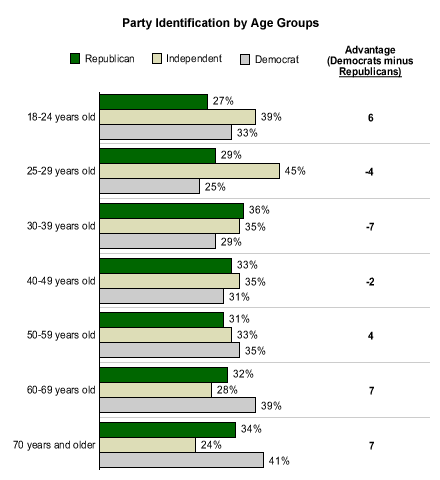The midterm congressional elections on Nov. 5 mark the first time that many young people will be voting, and those votes may carry more weight than usual this year. With the Senate majority hanging on one seat and the House majority on six seats, every single vote has the potential to tip the balance. Moreover, investigating the voting tendencies of young people is interesting for the clues it gives to long-term political trends.
So which political parties do young American adults identify with today? Do young people think of themselves as Republicans or Democrats? A review of Gallup polling over the past several months shows that young adults are currently more inclined to identify themselves as Democrats rather than Republicans, but not by an overwhelming margin.
Since 1944, Gallup has been asking the American public the question: "In politics, as of today, do you consider yourself a Republican, a Democrat or an independent?" In order to closely examine young adults' political preferences, Gallup combined the results of its party identification question from 10 surveys conducted between July and September of this year*.

Independent Thinking
More 18- to 24-year-olds identify themselves as Democrats (33%) than as Republicans (27%). The plurality (39%), however, regard themselves as independents.
People in their late 20s (those between 25 and 29), on the other hand tend to be more aligned with the Republican Party than the Democratic Party. Just about three in 10 (29%) 25- to 29-year-olds say they are Republicans, compared to 25% who identify themselves as Democrats. More than four in 10 (45%) adults in this age group, however, do not affiliate themselves with either of the major parties. Americans in their 30s are also more likely to be Republicans than Democrats, by a 36% to 29% margin. Thirty-five percent of adults in this age category are independents.
Overall, Americans below the age of 30 are far more likely to consider themselves to be political independents than do Americans 30 or older.
These differences are influenced by both generational and life-stage influences. Younger Americans, who have had less time to become active in politics and came of age during the Clinton years, are less likely to be aligned with either of the major parties. Americans between the ages of 30 and 49 came of age during the Reagan and Bush years of 1980-1992, and because most in this age group are already established financially, pocket-book concerns such as taxes may cause them to favor the Republican Party. Many older Americans (aged 60 and older) were introduced to politics during a long period of Democratic domination from 1933 to 1968, when that party held the presidency for all but eight years and Congress for all but four years. The Democratic Party's positions on issues such as Social Security and Medicare are also widely perceived to be as friendlier to older Americans' interests.
Key Points
Americans in the 18-to-24 age group are somewhat more likely than adults in their late 20s, 30s and 40s to say their political affiliation lies with the Democratic Party, but the differences between those who are Republicans and those who are Democrats in the 18-to-24 age group are not overwhelming. In fact, they are consistent with an overall electorate that is closely divided between the two major parties. However, the largest group of Americans in this age category say they are independents.
Older Americans, particularly those aged 60 and older, are just as likely as these younger Americans -- if not more likely -- to identify themselves with the Democratic Party.
With the exception of adults between the ages of 18 and 24, the likelihood that respondents will consider themselves to be Democrats steadily increases with a respondent's age. One quarter of people aged 25 to 29 say they are Democrats, compared to just about three in 10 adults in their 30s and 40s, more than a third of adults in their 50s, and roughly four in 10 adults aged 60 and older. But the political affiliation that loses adherents most steadily above age 24 is not Republicans, but independents.
*Results are based on telephone interviews with 6,673 national adults, aged 18 and older, conducted July-September 2002. For results based on the total sample of national adults, one can say with 95% confidence that the maximum margin of sampling error is ±1%. In addition to sampling error, question wording and practical difficulties in conducting surveys can introduce error or bias into the findings of public opinion polls.